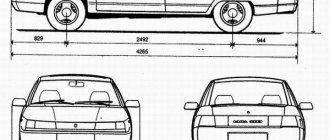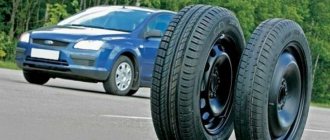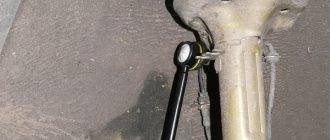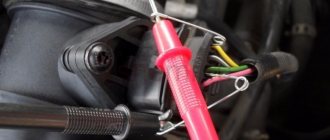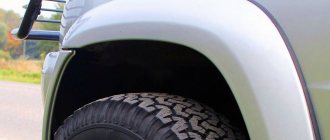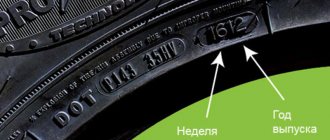- What is this?
- Long wheelbase
- Short wheelbase
- Which is better: long or short base?
- Is it possible to increase the center distance on your own?
- How to obtain information about the technical characteristics of the machine
The technical characteristics of cars indicate such a parameter as the wheelbase. It affects the vehicle's maneuverability and the comfort of passengers. This is an important characteristic to consider when choosing a vehicle.
What is this?
Wheelbase is the distance between the front and rear axle of a car. Otherwise it is called the inter-axle length of the machine. This parameter should not be confused with ground clearance - the ground clearance between the lowest point of the body and the road.
Depending on the wheelbase, the vehicle class is determined:
- A – up to 2400 mm;
- B – from 2400 to 2500 mm;
- C – from 2500 to 2750 mm;
- D – 2850 mm;
- E – from 2850 to 2950 mm.
For trucks, the distance between the axles is greater, about 8000 mm.
There are long and short wheelbases of a car, which affect handling, maneuverability and comfort. Each type has advantages and disadvantages.
Conclusion
As mentioned earlier, the wheelbase in a modern car is an extremely important indicator, taking into account which you can evaluate the dynamic performance of the car, its comfort, as well as maneuverability and ability to hold the road regardless of speed. Of course, the term should be understood correctly by every driver and in no case should it be confused with ground clearance, for the simple reason that such knowledge will subsequently allow you to avoid a whole series of troubles.
Author: Oleg Mokrov
Long wheelbase
The base of the car affects many characteristics of the car. And it is generally accepted that the greater the distance between the axles, the better the maneuverability and controllability. In fact, long wheelbases are found predominantly in premium cars.
The main advantage of the large distance between the axles is comfortable conditions for passengers. The distance between the seats is quite large, so you don’t have to rest your knees on the chairs. Such machines are especially convenient for tall people.
The long wheelbase of the car ensures a smooth ride; on uneven sections of the road the car does not jump and passes obstacles quite easily. We can safely say that not only passengers, but also drivers are comfortable in such cars.
Another advantage is ease of acceleration, less chance of skidding during a sharp turn. This feature is explained by the fact that such cars require less weight redistribution, ensuring a stable position on the road.
Most long wheelbase vehicles are front wheel drive. And this determines another important advantage - ease of maintenance. Repairing such cars is cheaper than rear-wheel drive ones.
Braking distance formula
Stopping distance formula
If a driver applies the brakes of a car, the car will not stop immediately. Braking distance is the distance a car travels before resting. This depends on the speed of the car and the coefficient of friction ( μ
) between the wheels and the road. This stopping distance formula does not include anti-lock brakes or brake bleeding. The SI unit for braking distance is meters.
d
= braking distance (
m
)
v
= car speed (
m/s
)
μ
= coefficient of friction (no units)
G
= acceleration due to gravity (9.80 m/s2)
Braking distance formula Questions:
1) A driver in a car on the street lives at a speed of 50.0 km/h
.
She hits the brakes when she sees a stop sign. The coefficient of friction between the tires and the road is μ,
= 0.60. What is the braking distance of a car?
Answer: The speed of the car must be converted to meters per second:
v = 13.89 m/s
The braking distance can be found using the formula:
d = 16.40 m
The braking distance of the car is 16.40 m.
2) A driver in a car on an icy road is traveling at 100.0 km/h
.
He hits the brakes and starts to slide. The coefficient of friction between tires and ice on the road is µ,
= 0.15. What is the braking distance of a car?
Answer: The speed of the car must be converted to meters per second:
v = 27.78 m/s
The braking distance can be found using the formula:
d = 262.4 m
The braking distance of a car on an icy road is 262.4 m
.
Braking distance formula
, Braking distance, reaction distance and braking distance
Reaction distance
Reaction distance is the distance you travel from the point where you detect a hazard before you start to brake or swerve.
Reaction distance depends on
- Vehicle speed (proportional increase): 2 x greater speed = 2 x greater reaction distance.
- 5x speed = 5x reaction distance.
- Typically 0.5–2 seconds.
Reaction distance can be reduced by
- Forecasting hazards.
- Readiness.
Reaction distance can be increased by
Simple Method: Calculate Reaction Distance
Formula: Remove the last digit in speed, multiply by reaction time and then by 3.
Example calculation with a speed of 50 km/h and a reaction time of 1 second:
50 km/h ⇒ 5 5 * 1 * 3 = 15 meters reaction distance
More accurate method: Calculate reaction distance
Formula: d = (s * r) / 3.6
d = reaction distance in meters (calculated). c = speed in km/h. r = reaction time in seconds. 3.6 = fixed figure for converting km/h to m/s.
Example calculation with a speed of 50 km/h and a reaction time of 1 second:
(50*1)/3.6=13.9m reaction distance
Braking distances
Braking distance is the distance a car travels from the point where you start braking until the car stops.
The braking distance is affected
- Vehicle speed (quadratic; "increased to the power of 2"): 2 x higher speed = 4 x longer stopping distance.
- 3 times the speed = 9 times the braking distance.
Calculate braking distance
It is very difficult to achieve reliable braking distance calculations because road conditions and tire grip can vary greatly. Braking distances can be, for example, 10 times longer when there is ice on the road.
Simple method: Calculate braking distance
Conditions: Good and dry road conditions, good tires and good brakes.
Formula: Remove the zero from the speed, multiply the number by itself, and then multiply by 0.4.
Figure 0.4 is taken from the fact that the braking distance from 10 km/h in dry road conditions is approximately 0.4 meters. This was calculated with the help of researchers measuring stopping distances. So in a simplified formula, we base our calculations on a braking distance of 10 km/h and increase it quadratically as speed increases.
Example calculation with a speed of 10 km/h:
10 km/h ⇒ 1 1 * 1 = 1 1 * 0.4 = 0.4 m braking distance
Example calculation with a speed of 50 km/h:
50 km/h ⇒ 5 5 * 5 = 25 25 * 0.4 = 10 meters braking distance
More accurate method: Calculate braking distance
Conditions: Good tires and good brakes.
Formula: d = s 2 / (250 * f)
d = braking distance in meters (calculated). c = speed in km/h. 250 = fixed figure that is always used. f = friction coefficient, approx. 0.8 on dry asphalt and 0.1 on ice.
Example calculation with a speed of 50 km/h on dry asphalt:
50 2 / (250 * 0.8) = 12.5 meters braking distance
Braking distances
Braking distance = reaction distance + braking distance
Calculate stopping distance with these simple methods
It's summer and the road is dry. You are driving at a speed of 90 km/h in a car with good tires and brakes. You suddenly notice danger on the road and brake hard. How long will the stopping distance be if your reaction time is 1 second?
Braking distance - reaction distance + braking distance. First we will calculate the reaction distance:
- 90 km/h ⇒ 9
- 9 * 1 * 3 = 27 meters reaction distance
Then we calculate the braking distance:
- 90 km/h ⇒ 9
- 9 * 9 = 81
- 81 * 0.4 = 32 meters braking distance
Now both distances are combined:
- 27 + 32 = braking distance
Important clarifications regarding calculations
Different methods give different answers. Which one should I use? - Use whatever you want. The differences are so small that they will not affect your test of the theory, since the margins between the alternatives are quite large.
So if the alternatives are 10, 20, 40, 60, it doesn't matter if you get 10 meters with one method and 12.5 meters with the other - both are clearly closer to 10, which is therefore the correct answer.
Last update 2019-06-13.
,
Short wheelbase
Despite the many advantages of a long wheelbase, vehicles with short axle spacing are in great demand. This is explained by the numerous advantages of such machines:
- Excellent maneuverability and controllability even at high speed. Drivers note that such cars listen better and the steering wheel is soft. These parameters are especially important in urban conditions, when it is important to change lanes correctly and on time, overtake and take turns.
- High cross-country ability, allowing the vehicle to be used off-road. Such vehicles have a higher ramp angle, which allows them to overcome difficult obstacles in the form of uneven road surfaces. True, the ride cannot be called ideal, except for premium SUVs that can easily drive through holes, potholes and other obstacles.
- Good stability when driving at high speed. Cars with a short wheelbase are designed to drive fast, although they make turns more difficult and the rear end can skid. Although it is easier to get such a car out of a skid than with a long wheelbase.
Most modern urban crossovers and SUVs have an optimal ratio of short wheelbase and overall body length. This determines most of the advantages: convenience for passengers, good handling and maneuverability.
Let's sum it up
To summarize, let’s say that independently changing the ground clearance and wheel track is, in principle, acceptable, but it will directly affect the working life of the vehicle’s chassis. The wheelbase cannot be changed. Its size cannot be adjusted. For our part, we would not recommend making any modifications at all. Don’t think that your ideas can improve engineering schemes, which, by the way, entire design and testing bureaus are working on. The only thing you will achieve is increased wear and tear on the car. The improvement in the indicators themselves will be barely noticeable. It is better to initially choose a car model that will completely satisfy you.
Which is better: long or short base?
It used to be that the wheelbase determined the majority of a car's performance characteristics. And when determining the distance between the axles for the future car, the characteristics of competitors' cars were taken into account. To get ahead of other manufacturers, engineers increased the center distance by several millimeters. And only after a detailed study of the car’s behavior on the road was it possible to find out that controllability and maneuverability are influenced by a combination of parameters: ground clearance, body length and wheelbase.
It is impossible to say definitely at what base the car drives better and copes with road obstacles. The peculiarities of transport operation and personal preferences should be taken into account. So, if you like traveling long distances on highways and off-road, then choose a car with a long wheelbase. A similar choice should be made when choosing a luxury car for the purpose of transporting passengers.
For driving within the city, when maneuverability on narrow streets is important, cars with a short wheelbase are suitable. If you need comfort for passengers, then preference should be given to a model with a long body.
As for cost, there are representatives of both types in the budget and premium classes. At the same time, a long wheelbase is not an indicator of prestige. For example, Gazelles and vans also have a wide distance between the axles, but this does not classify them as an elite line of vehicles.
A little about trucks
Trucks are also divided into short and long axle distances. But here it is more pronounced.
So, for example, “tractors”, vehicles that pull trucks (road trains), always have a short wheelbase; it allows them to maneuver perfectly, as well as have better maneuverability and weight distribution. Often, two axles are installed at the rear in order to withstand the pressure of the truck!
But dump trucks or trucks, on the contrary, have an extended size. This is because they need to hold the body or van with a load on top. And the load is calculated taking into account the load condition - that’s why these cars jump so much without a load, and when loaded they go smoothly.
But in general, trucks also maintain a ratio of 1.6 - 1.8; it is universal, regardless of the dimensions, ground clearance, weight and class of the vehicle.
That's all, I tried to open all aspects, I think you liked it. Read our AUTOBLOG.
Similar news
- How to disassemble the Starline E90 (E93, E95, E95) key fob. Details + vi…
- Do-it-yourself dry cleaning of the car interior. Let's try LAVR, my review...
- The headlight is sweating, what should I do? A phenomenon from within. Step-by-step instruction
Add a comment Cancel reply
Is it possible to increase the center distance on your own?
Theoretically, you can change the width between the axes. But in practice this is quite difficult and expensive. Making changes to the basic characteristics of a machine is fraught with negative consequences:
- rapid wear of the suspension;
- failure of bearings and struts;
- protrusion of the wheels beyond the arch, which will cause the body to be covered with dirt.
It is important to remember that making changes to the characteristics of a car is illegal without prior approval from the traffic police. This can result in administrative penalties and a requirement to return the original parameters. Therefore, it is not worth changing the wheelbase - this has more disadvantages than advantages.
Is it permissible to independently change the main technical parameters of a car?
Every driver wants to configure his car so that it has optimal performance. This is almost impossible to achieve. Often, by improving some parameters, car enthusiasts worsen others.
Increasing clearance occurs in different ways. The simplest of them is installing wheels of larger diameter, or using spacers. Do not forget that by changing the height of the road gap, you disrupt the adjustment of the interaction angles of all driving elements. Because of this, they seriously lose their working life, and the car’s handling deteriorates significantly. Civil vehicles have a very weak tendency to increase ground clearance. This is mainly permissible for off-road vehicles with a frame structure.
During the industrial production of cars, manufacturers must strictly maintain the relationship between the track size and the size of the wheelbase. The ratio of their values should not be less than 1.6. An increase in this ratio is quite acceptable. It has a positive effect on the smooth running of the car, which significantly increases its comfort. An example of such solutions are limousines, the longitudinal length of which is noticeably greater than the track of their wheels. Let’s say right away that you won’t be able to change the size of the wheelbase yourself. This is a static value that is set directly by the manufacturer.
With an increase in wheel track, everything is also very difficult. Its increase is possible by using wider wheels and tires, as well as by increasing the width of the axles. With the first method, we think everything is clear, but increasing the size of the axes requires special attention. It is mainly used in professional motorsport. The track of cars is changed by cutting the beam in the center, installing an additional part and welding them in a circle. The main condition for carrying out these complex manipulations is the exact matching of the dimensions of the insert and the axis, as well as the use of the same material for their manufacture. It is important to understand that as the vehicle’s stability improves, the load on the main parts of its suspension increases significantly. It begins to function at extreme and sometimes extreme loads, which quickly disables it.

